The Critical Decade - Part 2: Climate Risks
Posted on 1 June 2011 by dana1981
The Australian government established a Climate Commission which recently released a three chapter report entitled The Critical Decade. In Part 1, we examined Chapter 1 of the report, which summarizes the current state of climate science observational data. In this second part of the series, we will examine Chapter 2 of the report, which discusses the risks associated with a changing climate. The quotes and bullets below come directly from the report, while the remainder is our commentary.
Sea Level Rise
Chapter 2 begins with an assessment of the risks associated with sea level rise:
-
A plausible estimate of the amount of sea-level rise by 2100 compared to 2000 is 0.5 to 1.0 m. There is significant uncertainty around this estimate, the largest of which is related to the dynamics of large polar ice sheets.
-
Much more has been learned about the dynamics of the large polar ice sheets through the past decade but critical uncertainties remain, including the rate at which mass is currently being lost, the constraints on dynamic loss of ice and the relative importance of natural variability and longer-term trends.
-
The impacts of rising sea-level are experienced through “high sea-level events” when a combination of sea-level rise, a high tide and a storm surge or excessive run-off trigger an inundation event. Very modest rises in sea-level, for example, 50 cm, can lead to very high multiplying factors – sometimes 100 times or more – in the frequency of occurrence of high sea-level events.
The report discusses the fact that the IPCC Fourth Assessment Report (2007) did not take into account the loss of ice due to dynamical processes in the large polar ice sheets (on Greenland and Antarctica). Semi-empirical models (i.e. Vermeer and Rahmstorf 2009) project up to a 2 meter sea level rise by 2100 by incorporating the observed acceleration of sea level rise during the 1990–2009 period, although the report concludes that projections of 1.5–2.0 meter sea level rise by 2100 seem high in light of recent questions surrounding estimates of the current rate of mass loss from polar ice sheets (Bromwich and Nicolas 2010).
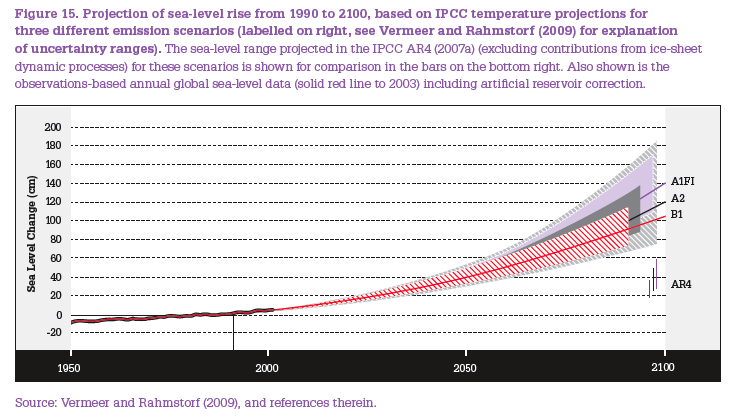
Looking specifically at Australia, a 0.5 meter sea level rise would greatly increase the incidence of extreme high sea-level events, particularly in Sydney and Melbourne:
"For coastal areas around Australia’s largest cities – Sydney and Melbourne – a rise of 0.5 m leads to very large increases in the incidence of extreme events, by factors of 1000 or 10,000 for some locations. A multiplying factor of 100 means that an extreme event with a current probability of occurrence of 1-in-100 – the so-called one-in-a-hundred-year event – would occur every year. A multiplication factor of 1000 implies that the one-in-a-hundred-year inundation event would occur almost every month."
In other words, even if sea level rise is at the very low end of projections, many coastal cities like Sydney will experience a high frequency of flood events.
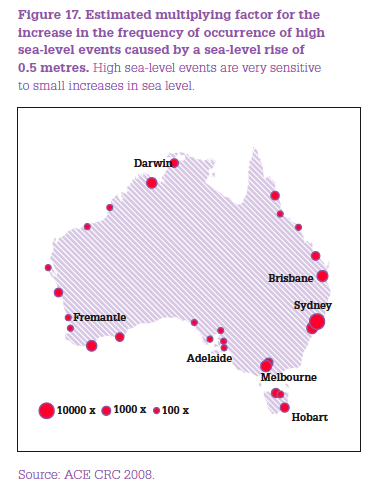
Ocean Acidification
The report proceeds to examine the projected rate of change and impacts from ocean acidification:
-
The contemporary rate of increase in ocean acidity (decrease in alkalinity) is very large from a long-time perspective.
-
The effects of increasing acidity are most apparent in the high latitude oceans, where the rates of dissolution of atmospheric CO2 are the greatest.
-
Increasing acidity in tropical ocean surface waters is already affecting coral growth; calcification rates have dropped by about 15% over the past two decades.
-
Rising SSTs have increased the number of bleaching events observed on the Great Barrier Reef (GBR) over the last few decades. There is a significant risk that with a temperature rise above 2 °C relative to pre-industrial levels and at CO2 concentrations above 500 ppm, much of the GBR will be converted to an algae-dominated ecosystem.
Chapter 2 contains a rather striking figure of ocean pH over the past 25 million years and projected to 2100:
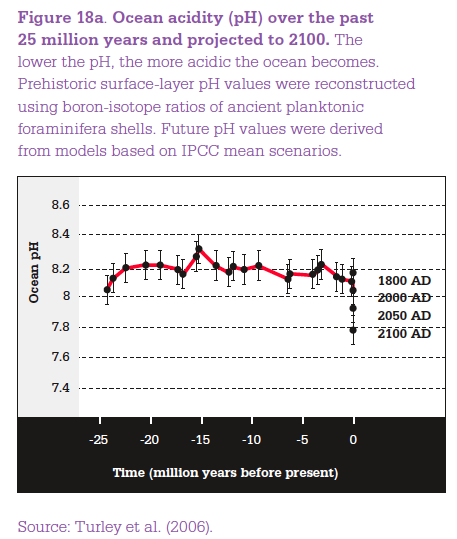
The impacts of increasing ocean acidity are already evident in some marine species, and there is evidence that acidification is already impacting the GBR and other coral reefs. If global temperatures rise more than 2°C above today's levels, it's anticipated that reefs will no longer be dominated by corals, as they will be adversely impacted by both acidification and rising ocean temperatures.
Water Cycle
The next section of the chapter examines the risks associated with the water cycle, which are of particular concern to Australia, as the driest of the world's six inhabited continents.
-
Observations since 1970 show a drying trend in most of eastern Australia and in southwest Western Australia but a wetting trend for much of the western half of the continent.
-
Given the high degree of natural variability of Australia’s rainfall, attributing observed changes to climate change is difficult. There is no clear trend, either in observations or model projections, for how the major mode of variability, ENSO, is responding to climate change. Evidence points to a possible climate change link to observed changes in the behaviour of the Southern Annular Mode (SAM) and the Indian Ocean Dipole (IOD).
-
Improvements in understanding of the climatic processes that influence rainfall suggest a connection to climate change in the observed drying trend in southeast Australia, especially in spring. In southwest Western Australia, climate change is likely to have made a significant contribution to the observed reduction in rainfall.
-
The consensus on projected changes in rainfall for the end of this century is (i) high for southwest Western Australia, where almost all models project continuing dry conditions; (ii) moderate for southeast and eastern Australia, where a majority of models project a reduction; and (iii) low across northern Australia. There is a high degree of uncertainty in the projections in (ii) and (iii), however.
-
Rainfall is the main driver of runoff, which is the direct link to water availability. Hydrological modelling indicates that water availability will likely decline in southwest Western Australia, and in southeast Australia, with less confidence in projections of the latter. There is considerable uncertainty in the projections of amounts and seasonality of changes in runoff.
In short, southwest Western Australia is likely to continue becoming very dry, but teasing out the impacts of global warming on the rest of the country's water supply is a challenge. In fact climate change could lead to more extremes in general, in both drought and rainfall in Australia. What the report does note is that once again, uncertainty is not our friend.
"This daunting uncertainty not only challenges attempts at adaptation, but also enhances, not diminishes, the imperative for rapid and vigorous global mitigation of greenhouse gas emissions."
Extreme Events
The next section of Chapter 2 relates to extreme events such as heatwaves, bushfires, heavy precipitation events, and storms.
-
Modest changes in average values of climatic parameters – for example, temperature and rainfall – can lead to disproportionately large changes in the frequency and intensity of extreme events.
-
On a global scale and across Australia it is very likely that since about 1950 there has been a decrease in the number of low temperature extremes and an increase in the number of high temperature extremes. In Australia high temperature extremes have increased significantly over the past decade, while the number of low temperature extremes has decreased.
-
The seasonality and intensity of large bushfires in southeast Australia is likely changing, with climate change a possible contributing factor. Examples include the 2003 Canberra fires and the 2009 Victoria fires.
As we know, we can't attribute individual extreme weather events to climate change, but we can say that global warming is "loading the dice" and making these sorts of events more likely to happen. On average, heatwaves and bushfires are becoming more intense, for example, and will continue to do so as the planet continues to warm. It is also plausible that by increasing atmospheric water vapor, global warming will lead to more extreme rainfall and flood events, and the report concludes that we should prepare for this contingency.
Abrupt Change and Tipping Points
The next section of Chapter 2 discusses abrupt, non-linear, irreversible changes in the climate system.
-
A number of potential abrupt changes in large sub-systems or processes in the climate system – so-called “tipping elements” – have been identified largely through palaeo-climatic research. Many of these, if triggered, would lead to catastrophic impacts on human societies.
-
Examples of tipping elements include abrupt changes in the North Atlantic ocean circulation, the switch of the Indian monsoon from a wet to a dry state or vice versa, and the conversion of the Amazon rainforest to a grassland or a savanna.
-
Very large uncertainties surround the likelihood, or not, of human-driven climate change triggering any of these abrupt or irreversible changes. Experts agree that the risk of triggering them increases as temperature rises.
-
Abrupt shifts in atmospheric circulation can occur very quickly and can have large impacts on regional climates. The recent cold, snowy winters in northern Europe, and their possible link to climate change, comprise a good example of this risk.
The report identifies a number of policy-relevant climate tipping elements throughout the world (click here for larger image) and examines the likelihood of passing some of these tipping points, and the risk associated with these scenarios:
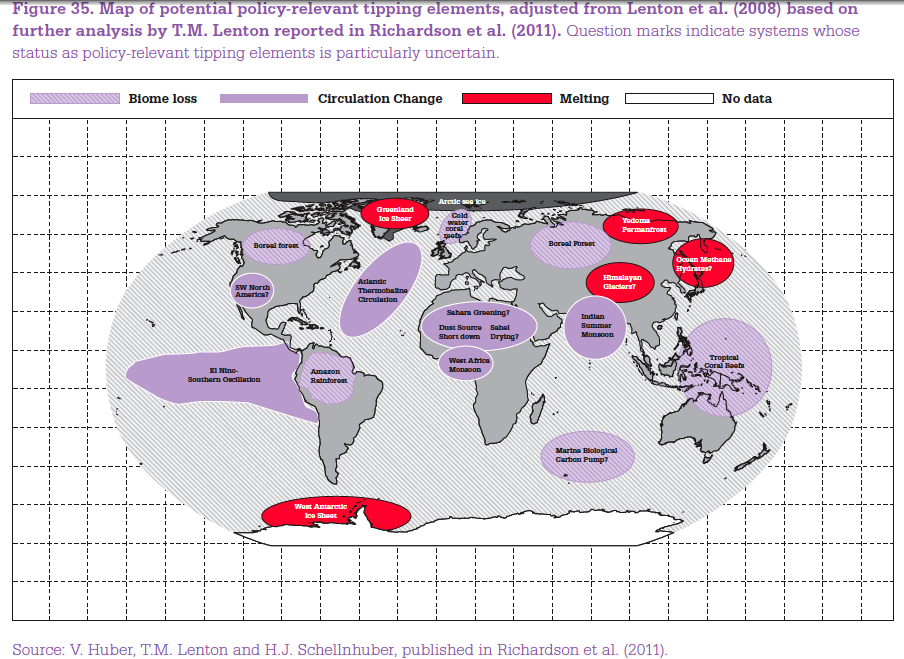
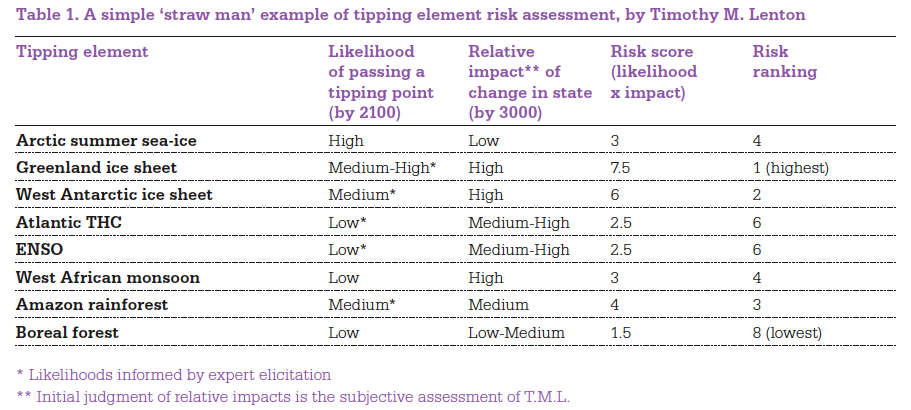
As you can see, the potentially rapid decline of the ice sheets and associated sea level rise represent the highest risk, followed by the loss of Amazon rainforest and Arctic sea ice.
Summary
In short, there are a lot of diverse risks associated with continued climate change. While there is a significant amount of uncertainty associated with some of these risks, we can't simply hope they won't happen or pretend the risks don't exist. Risk assessment and management involves taking all potential risks into account and determining the most effective way to reduce them. On that note, in Part 3 we will examine the report's conclusions regarding the science implications on future carbon emissions reductions.































 Arguments
Arguments






























[dana1981] Thanks very much. I agree it's a very good report.
[dana1981] Thanks. I think certain parties confuse "alarmist" with "alarming". I agree, there's nothing alarmist about this report, but it does contain some alarming information. Unfortunately reality is rather alarming right now.
[dana1981] Sea level rise is far from the only consequence of climate change. As Thompson has said, there will be some degree of mitigation, adaption, and suffering. The less we mitigate, the more we will have to adapt and suffer.
[dana1981] Please stop cherrypicking the last 10 years. Moreover, Trenberth has a draft paper out where he suggests the location of the 'missing heat':
[dana1981] Well said. I always enjoy a bit of good sarcasm!
[DB] Please, can everyone refrain from attaching the appellation of "troll/trolling"? If you feel a comment is off-topic, challenge the originator of the comment, appropriately and within the confines of the Comments Policy and direct them to a more appropriate thread.
This forum belongs to all of you. Self-policing will keep other activities to a minimum. For those, bring it to the attention of the moderators. Because sometimes we miss stuff. Happens. :(
[dana1981] Indeed, we have a post on this bleak news coming in the very near future. Stay tuned.
[DB] "Could someone explain to a person not born in the 1980's (me) what is 'trolling'? I have not completed a course in SKS-speak."
From the Wiki:
Note that any SkS usage is the same as above.